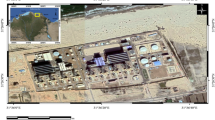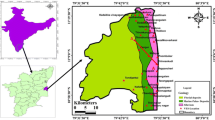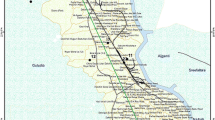Abstract
The investigated region is located in the western desert fringes of the Nile Valley which requires studies of groundwater related to the many projects of land reclamation. The key objective of this paper is to estimate the qualitative and geometrical features of the investigated aquifer. Using 60 vertical electrical sounding and time-domain electromagnetic soundings allows us to suggest one possible model of the geometrical features of the local aquifer. A hydrogeological monitoring has been undertaken to investigate the current groundwater situation at the Gallaba plain. Such hydrological monitoring has not been undertaken before in detail. The results show that the investigated region has high groundwater potentialities in two main aquifers which belong to Pleistocene: shallow fresh water and deep brackish water. The lithological and structural elements contribute mainly to recharge and store the groundwater in the western part of the River Nile in Kom Ombo graben. The geochemical properties of the groundwater of the studied aquifers reflect meteoric water, which is a fresh to slightly brackish water. The small amount of groundwater salinity arises from silicate weathering and evaporation processes occurring in the aquifer matrix. Moreover, most of the studied groundwater samples are unfit for human consumption. Such samples are very satisfactory for livestock and poultry purposes and they can be used for irrigation using modern and improved irrigation methods e.g. sprinkler and drip methods. Furthermore, the hydrogeological monitoring of the concerned area indicates that it has high groundwater potentialities which will support its sustainable development.










Similar content being viewed by others
References
Abd El-Razik, T., & Razavaliaev, A. (1972). On the tectonic origin of the Nile Valley between Idfu and Qena. Egypt Journal of Geology,16(2), 235–245.
Aghazadeh, N., & Mogaddam, A. A. (2010). Assessment of groundwater quality and its suitability for drinking and agricultural uses in the Oshnavieh Area, Northwest of Iran. Journal of Environmental Protection,1, 30–40. https://doi.org/10.4236/jep.2010.11005.
Ahmed, W., Sauck, W., Sultan, M., Yan, E., Soliman, F., & Rashed, M. (2014). Geophysical constraints on the hydrogeologic and structural settings of the Gulf of Suez Rift-related Basins: Case study from the El Qaa Plain, Sinai, Egypt. Surveys in Geophysics,35, 415–430. https://doi.org/10.1007/s10712-013-9259-6.
AIE-2 TDEM. http://zond-geo.com/english/services/equipment/aie-2-instruments/.
Alekin, A. (1970). Fundamentals of hydrochemistry. Leningrad: Gidrometeoizdat. (in Russian).
Ali, M. Y. (2003). Micropaleontological and stratigraphical analyses of the Late Cretaceous/Early Tertiary succession of the Southern Nile Valley (Egypt). PhD, Universität Bochum, Germany, p. 197.
Allam, M. N., & Allam, G. I. (2007). Water resources in Egypt: Future challenges and opportunities. Water International,32, 205–218. https://doi.org/10.1080/02508060708692201.
American Public Health Association (APHA). (2012). Standard methods for the examination of water and wastewater (22nd ed., p. 1496). Washington, DC: APHA, American Water Works Association.
AQUASCHEM V.3.7. Water quality analysis and geochemical modeling. https://www.waterloohydrogeologic.com/product/aquachem/.
Basheer, A. A., & Mosaad, S. (2018). Geophysical and hydrogeological evaluation of pliocene aquifer in East Esna, Egypt. Pure and Applied Geophysics,1, 4. https://doi.org/10.1007/s00024-018-1768-2.
Conoco (1987). A geological maps of Egypt, 1:500000, Luxor sheet.
D’Appolonia, (2016). Investigative study of the hydraulic fracturing and seismic activities conducted by DANA GAS. Internal report prepared by D’AppoloniaCo. Egypt: KomOmbo Concession.
Dionex ICS-1100. Ion chromatography system operator’s manual 2012 by Thermo Fisher Scientific Inc.
Ebraheem, A. M., Garamoon, H. K., Riad, S., Wycisk, P., & El Nasr, A. S. (2003). Numericalmodeling of groundwater resource management options in the East Oweinat area, SW Egypt. Environmental Geology,44(4), 433–447.
El Bastawesy, M., Faid, A., & Gammal, E. S. (2010). The Quaternary development of tributary channels to the Nile River at Kom Ombo area, Eastern Desert of Egypt, and their implication for groundwater resources. Hydrological Processes Journal,24, 1856–1865. https://doi.org/10.1002/hyp.7623.
El Shazly, E. M., Abdel Hady, M. A., El Ghawaby, M. A. & El Kassas, I. A. (1974). Geologic interpretation of ERTS-1 satellite images for west Aswan area, Egypt. In Proceedings of the ninth international symposium on remote sensing of environment, 15–19 April (1974), Arbor.
ERDAS Software. 2018. https://www.hexagongeospatial.com/.
ESRI. (2011). ArcGIS desktop: Release 10. Redlands: Environmental Systems Research Institute.
Fisher, R. S., & Mullican, F. W. (1997). Hydrochemical evolution of sodium–sulfate and sodium–chloride groundwater beneath the Northern Chihuahuan Desert, Trans-Pecos, Texas, USA. Hydrogeology Journal,10(4), 455–474.
Freeze, R., & Cherry, A. (1979). Groundwater (p. 604). Upper Saddle River: Prentice-Hall.
Gaber, A., Koch, M., Helmi, M., & Sato, M. (2011). SAR remote sensing of buried faults: Implications for groundwater exploration in the Western Desert of Egypt. Sensing and Imaging: An International Journal,12, 133–151. https://doi.org/10.1007/s11220-011-0066-1.
Gaber, A., Soliman, F., Koch, M., & El-Baz, F. (2015). Using full-polarimetric SAR data to characterize the surface sediments in desert areas: A case study in El-Gallaba Plain, Egypt. Remote Sensing of Environment,162(2015), 11–28.
Ghoneim, E., Robinson, C., & El-Baz, F. (2007). Radar topography data reveal drainage relics in the eastern Sahara. International Journal of Remote Sensing,28, 1759–1772.
Gibbs, R. J. (1970). Mechanisms controlling world water chemistry. Science,170(3962), 1088–1090.
Hewaidy, A. A., & Soliman, S. I. (1993). Stratigraphy and Paleoecology of Gabal El-Borga, south-west KomOmbo, Nile Valley, Egypt. Egyptian Journal of Geology,37, 299–321.
Idris, H., & Nour, S. (1990). Present groundwater status in Egypt and the environmental impacts. Environmental Geology and Water Sciences,16(3), 171–177.
International Center for Agricultural Research in the Dry Areas (ICARDA). (2011). Water and Agriculture in Egypt. Technical Paper Based on the Egypt-Australia-ICRDA workshop on On-farm Water-use Efficiency, Cairo, Egypt.
Issawi, B. (1978). Geology of Nubia West Area, Western Desert. Annals of the Geological Survey of Egypt,III, 237–253.
Issawi, B. (1983). Ancient rivers of the Eastern Egyptian Desert. Episodes,2(1983), 3–6.
Issawi, B., El-Hinnawi, M., Francis, M., & Mazhar, A. (1999). The Phanerozoic geology of Egypt—a geodynamic approach (p. 462). Cairo: The Egyptian Geological Survey Press.
Issawi, B., Francis, M., Youssef, A., & Osman, R. (2009). The phanerozoic of Egypt: A geodynamic approach. Geological Survey of Egypt Special Publications,81, 589p.
Issawi, B., & Hinnawi, M. (1980). Contribution to the geology of the Plain West of the Nile between Aswan and KomOmbo. In F. Wendorf & R. Schild (Eds.), Loaves and fishes: The Prehistory of WadiKubbaniya (pp. 311–330). Dallas: Southern Methodist University Press.
Issawi, B., & Osman, R. (1996). The sandstone enigma of south Egypt. In 3rd Conference on Geology of the Arab World. Cairo University, pp. 359–380.
Karmegam, U., Chidambaram, S., Prasanna, M. V., Sasidhar, P., Manikandan, S., Johnsonbabu, G., et al. (2011). A study on the mixing proportion in groundwater samples by using Piper diagram and Phreeqc model. Chinese Journal of Geochemistry,30, 490e495.
Klitzsch, E. (1986). Plate tectonics and cratonal geology in Northeast Africa (Egypt/Sudan). GeologischeRundschau,75, 755–775.
Koch, M., Gaber, A., Burkholder, B., & Geriesh, H. G. (2012). Development of new water resources in Egypt with earth observation data: Opportunities and challenges. International Journal of Environment and Sustainability,1(3), 1–11. (ISSN 1927-9566).
Kumar, M., Ramanathan, A. L., Rao, M. S., & Kumar, B. (2006). Identification and evaluation of hydrogeochemical process in the groundwater environment of Delhi, India. Environmental Geology,50, 1025–1039.
KW, Butzer, & Hansen, C. L. (1968). Desert and river in Nubia (p. 562). Madison: The University of Wisconsin Press.
Lansbery, L. (2011). Geological and geomorphological evolution of the Egyptian Nile between Aswan and KomOmbo: A remote sensing and field study approach. MS thesis. Missouri University of Science and Technology, Rolla, MO, p. 83.
Mckee, J. E., & Wolf, H. W. (1963). Water quality criteria. California State Water Quality Board Publication,3-A, 548.
Ministry of Agriculture and Land Reclamation (MALR). (2010). Sustainable Agricultural Development Strategy Towards 2030 (SADS). Cairo: Ministry of Agricultural and Land Reclamation.
Ministry of Planning (MOP). (2015). Citizen guide for the investment plan in Aswan Governorate 2015/2016.
National Academy of Science and National Academy of Engineering. (1972). Water quality criteria (p. 594). Washington, DC: Protection Agency.
Piper, A. M. (1944). A graphical procedure in the geochemical interpretation of water analysis. Eos Transactions American Geophysical Union,25, 914e923.
Redwan, M., & Abdel Moneim, A. A. (2015). Factors controlling groundwater hydrogeochemistry in the area west of Tahta, Sohag, Upper Egypt. Journal of African Earth Sciences. https://doi.org/10.1016/j.jafrearsci.2015.10.002.
Roden, J., Abdelsalam, M., Atekwana, E., El-Qady, G., & Tarabees, E. (2011). Structural influence on the evolution of the pre-Eonile drainage system of southern Egypt: Insights from magnetotelluric and gravity data. Journal of African Earth Sciences,61(2011), 358–368.
Said, R. (1962). The geology of Egypt (p. 377p). Amsterdam: Elsevier.
Said, R. (1993). The River Nile: Geology, hydrology and utilization, Pergamon, 1st ed (November 27, 1993).
Saleh, A. M., Belal, A. B., & Mohamed, E. S. (2015). Land resources assessment of El-Galababasin, South Egypt for the potentiality of agriculture expansion using remote sensing and GIS techniques. Egyptian Journal of Remote Sensing and Space Sciences,18, S19–S30. https://doi.org/10.1016/j.ejrs.2015.06.006.
Sallam, O. M., El Shewy, M. A., & Dawoud, M. A. (2014). New reclamation mega projects and increasing the pressure on water system in the Nile Valley and Delta in Egypt. https://doi.org/10.13140/RG.2.1.1845.4564. (Conference: WSTA 11th Gulf Water Conference, Water in the GCC. “Towards Efficient Management”, AtMuscat, Sultanate of Oman).
Schoeller, H. (1962). Les eauxsouterraines [Groundwater]. MassioetCie, Paris.
Senthilkumar, M., & Elango, L. (2013). Geochemical processes controlling the groundwater quality in lower Palar river basin, southern India. Journal of Earth System Science,122, 419e432.
SRTM 90m. Digital Elevation Database v4.1. https://doi.org/10.1007/s13157-012-0348-y.
Stallard, R. F., & Edmond, J. M. (1983). Geochemistry of the Amazon: 2 influence of geology and weathering environment on the dissolved load. Journal of Geophysical Research,88, 9671e9688.
SubbaRao, N. (2008). Factors controlling the salinity in groundwater in parts of Guntur district, Andhra Pradesh, India. Environmental Monitoring and Assessment,138, 327–341.
Sulin, V. (1946). Waters of petroleum formations in the system of natural waters (pp. 35–96). Moscow: Gostoptekhizdat.
Sultan, M., Yousef, A. F., Metwally, S. E., Becker, R., Milewski, A., Sauck, W., et al. (2011). Red sea rifting controls on groundwater reservoir distribution: Constraints from geophysical, isotopic, and remote sensing data. Geological Society of America Bulletin,123(5/6), 911–924. https://doi.org/10.1130/B30146.1.
Syscal-pro. http://www.iris-instruments.com/syscal-pro.html.
Thurmond, A. K., Stern, R. J., Abdelsalam, M. G., Nielsen, K. C., Abdeen, M. M., & Hinz, E. (2004). The Nubian Swell. Journal of African Earth Sciences,39, 401–407.
Toth, J. (1999). Groundwater as a geologic agent: An overview of the causes, processes, and manifestations. Hydrogeology Journal,7, 1–14.
U.S. Salinity Laboratory Staff. (1954). Diagonsis and improvement saline and alkali soil: Agric, handbook, 60, Washington DC, pp. 1–60.
World Health Organization (WHO). (2011). The guidelines for drinking-water quality, 4th ed. ISBN 978 92 4 154815 1, p. 564. http://www.who.int.
Zaghloul, Z. M., El-Shahat, A., & Ibrahim, A. (1983). On the discovery of Paleozoic trace fossils. Bifungites in the Nubian Sandstone facies of Aswan area. Egypt Journal of Geology,27, 25–72.
ZOND 1D Program. (2017). http://zond-geo.ru/english/zond-software/ert-and-ves/zondip1d/.
ZONDTEM1d Program. (2017). http://zond-geo.com/english/zond-software/electromagnetic-sounding/zondtem1d/.
Author information
Authors and Affiliations
Corresponding author
Additional information
Publisher's Note
Springer Nature remains neutral with regard to jurisdictional claims in published maps and institutional affiliations.
Rights and permissions
About this article
Cite this article
Mosaad, S., Basheer, A.A. Utilizing the Geophysical and Hydrogeological Data for the Assessment of the Groundwater Occurrences in Gallaba Plain, Western Desert, Egypt. Pure Appl. Geophys. 177, 3361–3382 (2020). https://doi.org/10.1007/s00024-019-02414-x
Received:
Revised:
Accepted:
Published:
Issue Date:
DOI: https://doi.org/10.1007/s00024-019-02414-x




